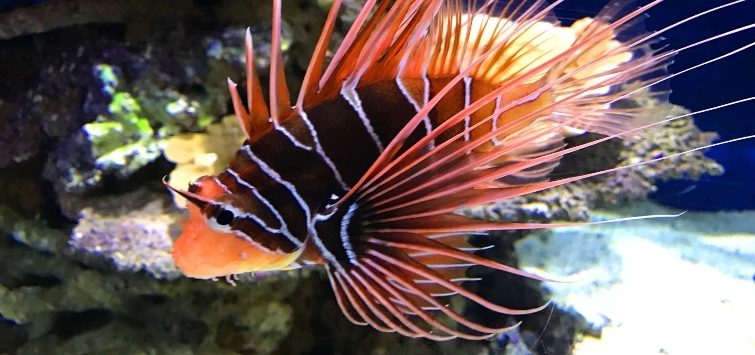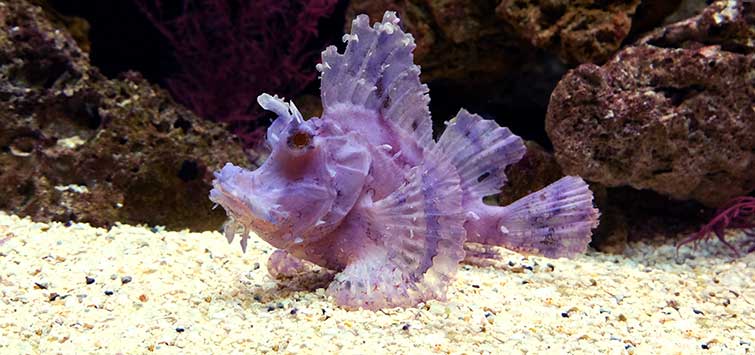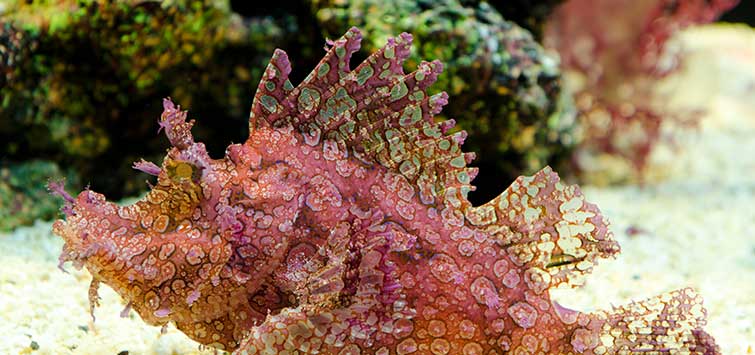Venomous Beauties: A Look at Scorpionfishes in the Home Aquarium
Author: Daniel Pomfret
Many aquarists have long been intrigued with the beautiful and dangerous scorpionfishes, and with the proper care and guidance they can make a striking display in the home aquarium.
Scorpionfish Basics
Scorpionfishes are sometimes overlooked in the wild due to their supreme camouflage, nocturnal habits, and generally solitary nature. For hobbyists, though, they are unusual fishes with character, color, and superb feeding habits, and they make a brilliant display for the home aquarium.
Scorpionfishes belong to the family Scorpaenidae with around 200 species in a couple dozen genera. They are found throughout the world’s oceans and have rather short, bulky bodies with highly venomous spines on their dorsal, pelvic, and anal fins. Some also have venomous spines on their gill plates and head. These spines are capable of delivering a potent and painful sting, which can cause intense pain, inflammation, nausea, and vomiting. Some people who are allergic to these peptide toxins can have respiratory or cardiac distress and could even die in rare cases.
These fish also produce a thin membranous skin cover which is used to foil the attachment of sessile organisms. This layer of skin is periodically shed to remove such organisms.
Most of the scorpionfish that are regularly available to the hobbyist are part of the subfamilies Scorpaeninae and Pteroinae, the latter of which includes the well-known lionfishes.
Hunting Habits
Scorpaeninae have excellent camouflage with feathery tassel growths, algal-encrusting skin, and the ability to change skin color to fit their surroundings. They hunt by lying motionless and deceiving prey animals that wander too close; the unsuspecting prey is swallowed in a vacuum of water within milliseconds.
Pteroinae are also ambush predators, but in the wild they prefer to come out of their rocky crevices and caves at dawn and dusk to feed. They can also corner prey to their advantage using elongated fin rays, and some even use decoy fins that act like a lure.
Scorpionfish are typically non-aggressive fish, but if threatened they will display warning colors and erect their fins before darting off a short distance away. Not much is known about their reproduction and breeding behavior and it has rarely been recorded in captivity, though they are known to produce floating eggs within a pelagic gelatinous mass.
Housing Requirements
Though scorpionfish are potentially dangerous animals, they are quite easy to keep in captivity. They are hardy, acclimate quickly, and if fed well on nutritious foods and provided good water quality, they will almost never be afflicted by disease or parasites.
Housing requirements vary between species. Aquarium capacities can start from 120 liters (30 gallons) and larger, but keep in mind that water quality parameters are easier to maintain in larger aquariums, especially if equipped with extra-large filtration units, so try to be as considerate as possible—it will pay off in the long run.
Aquascaping your aquarium also involves many variables. Habitats for scorpionfish in nature vary from rocky shores, coral reefs, coral rubble gardens, sandy bottoms, and seagrass beds. Lionfish can be kept in reef tanks, but other scorpionfishes are likely to damage corals by sitting on them. One must do a little research before acquiring a specimen, but it’s also important to make sure to decorate the aquarium appropriately.
Tankmate Selection
Choosing tankmates is a little tricky, too. Scorpionfish have huge mouths and are capable of swallowing prey half their own body length—and they will also eat ornamental shrimps and crabs. Angelfish and tangs have a habit of nipping at the skin of some scorpionfishes. One should note that in crowded aquariums lionfish may injure tankmates with their large poisonous fin rays.
I would suggest large bannerfish, triggerfish, sweetlips, groupers, snappers, puffers, and some types of eels. Same-species lionfish can be kept together, and they do well in small groups. In the wild I have seen a group of 14 Pterois volitans individuals—a species known to hunt in packs—resting on top of a deep overhang.
Feeding Methods
At first, newly acquired fish may only eat live foods such as river shrimp, mollies, or guppies. This isn’t a healthy diet; it’s very fatty and not natural, and it can lead to many gastrointestinal problems. For the greatest success in keeping scorpionfish one must wean them onto a mix of frozen foods like lance fish, white bait, prawn, crab, or squid.
The most common method used is to jiggle the food in close proximity to the fish, using a long stick, rod, or grippers. This jiggling mimics live prey. Thin acrylic rods are best for this method. If the fish are still reluctant to take frozen food, try feeding them at times when they would feed in nature: dusk, dawn, or at night.
Once the fish do accept frozen foods, you should apply a few drops of vitamin supplements for each meal. Make sure not to overfeed the fish; small portions three to four times a week is sufficient.
Possible Diseases and Treatment
Scorpionfish are pretty much disease resistant. But with weakened immunity due to poor water conditions, poor nutrition, or stress, they can contract a few ailments.
I have seen them contract ich infections, which can be treated with hyposalinity and copper-based medications. They can also get bacterial infections like fin rot and cloudy eye, which can be treated with antibiotics. But keep in mind, when treating reef aquarium fish with any type of medication, you must be sure to quarantine them from the main system—especially in the case of copper, which can be deadly to invertebrates even in trace amounts. Improper diet can cause gastrointestinal tract problems and blockage, or result in nutritional deficiencies. Excess skin molting is also a sign of ill health, and an investigation of the source of the problem should be carried out.
Notes of Caution
All scorpionfish are venomous, so aquarium position should involve careful consideration. Keep them out of reach of children and, if possible, display a warning label on the aquarium. Care also must be taken when transferring these fish. Their spines can easily be tangled in nets. It is better to catch them in a plastic container. If you do get stung, immerse the wound immediately in hot water for 30 minutes. Heat breaks down the venom and can prevent it from spreading. Then seek medical attention from your doctor or a nearby hospital. Usually the pain should subside within a few hours.
All in all, if a keen hobbyist wants a unique aquarium display and is willing to appreciate the dangers of keeping these fish, then scorpionfish may be the answer. They make great display animals and show fascinating behaviors.
References
Burgess, W. E., et al. 1991. Dr. Burgess’s Mini-Atlas of Marine Aquarium Fishes Mini Edition. T.F.H. Publications. Neptune City, NJ. pp. 114–122.
Eschmeyer, W. N. 1986 “Scorpaenidae.” In M. M. Smith and P. C. Heemstra (eds.) Smiths’ Sea Fishes. Springer-Verlag, Berlin. pp. 463–478.
Marini, F., PhD. “The Lionfish Info Sheet: Captive Care and Home Husbandry.” www.reefkeeping.com/issues/2002-11/fm/feature/index.php.
Michael, S. W. 1999. Marine Fishes: 500+ Essential-To-Know Aquarium Species. TFH/Microcosm Professional Series. Neptune City, NJ.
See the full article on TFH Digital http://www.tfhdigital.com/tfh/200710/#pg122

.png?h=595&iar=0&w=2781&hash=5FD5E69473BCC22199FBFA2FB71B6033)



